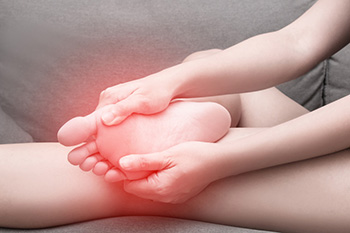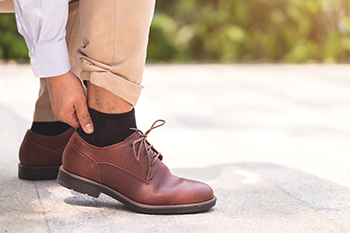NJ (908) 688-5577
NY (212) 737-2528

Almost everyone has felt some type of foot pain in their life, especially if they are physically active. However, foot pain also may be caused by genetics, diet, obesity, and infections. The most common causes of foot pain include bunions, hammertoes, and corns. Gout, flat feet, and plantar warts are other painful foot conditions. In addition, athlete’s foot, toenail fungus, and ingrown toenails are common foot pain complaints. Many of these conditions can be resolved by taking better care of the feet on a daily basis, as well as wearing shoes that fit the feet properly. Gout, however, is an inflammatory condition that results from having an excess of uric acid in the body. Omitting foods high in purines can help to prevent it. Infections are often transmitted in pool or gym locker rooms, with protective footwear they can be avoided. Caring for the toenails by cutting them properly may diminish the chances of an ingrown toenail. If you are experiencing foot pain that impedes your daily activities, it is suggested that you visit a podiatrist for help.
Foot Pain
Foot pain can be extremely painful and debilitating. If you have a foot pain, consult with Glenn Davison, DPM from Advanced Podiatry. Our doctor will assess your condition and provide you with quality foot and ankle treatment.
Causes
Foot pain is a very broad condition that could be caused by one or more ailments. The most common include:
Diagnosis
To figure out the cause of foot pain, podiatrists utilize several different methods. This can range from simple visual inspections and sensation tests to X-rays and MRI scans. Prior medical history, family medical history, and any recent physical traumatic events will all be taken into consideration for a proper diagnosis.
Treatment
Treatment depends upon the cause of the foot pain. Whether it is resting, staying off the foot, or having surgery; podiatrists have a number of treatment options available for foot pain.
If you have any questions, please feel free to contact our offices located in Union, NJ and New York . We offer the newest diagnostic and treatment technologies for all your foot care needs.

Diabetics can be in danger of foot and toe problems as a result of sustained high blood sugar levels. Commonly, diabetes causes neuropathy in the lower extremities, which results in numbness and can put the patient in danger of developing a foot ulcer. Because the feeling in the feet is limited or absent, cuts, sores, and cracks in the skin may go unnoticed. Another underlying condition, called peripheral artery disease, can clog the blood vessels in the feet, making it more difficult for any such injuries to heal. This combination can lead to skin ulcers that if not attended to can cause gangrene. Experts suggest a daily foot care regime that can prevent ulcers from forming. It includes washing and drying the feet daily, inspecting them for sores, wearing shoes that are comfortable and fit well, and avoiding going barefoot. Keep the feet elevated when possible and perform light foot exercises, such as wiggling the toes and rotating the ankles to get the circulation going. If you have noticed a sore on your foot that is taking a long time to heal, it is suggested that you make an appointment with a podiatrist.
Diabetic foot care is important in preventing foot ailments such as ulcers. If you are suffering from diabetes or have any other concerns about your feet, contact Glenn Davison, DPM from Advanced Podiatry. Our doctor can provide the care you need to keep you pain-free and on your feet.
Diabetic Foot Care
Diabetes affects millions of people every year. The condition can damage blood vessels in many parts of the body, especially the feet. Because of this, taking care of your feet is essential if you have diabetes, and having a podiatrist help monitor your foot health is highly recommended.
The Importance of Caring for Your Feet
Patients with diabetes should have their doctor monitor their blood levels, as blood sugar levels play such a huge role in diabetic care. Monitoring these levels on a regular basis is highly advised.
It is always best to inform your healthcare professional of any concerns you may have regarding your feet, especially for diabetic patients. Early treatment and routine foot examinations are keys to maintaining proper health, especially because severe complications can arise if proper treatment is not applied.
If you have any questions please feel free to contact our offices located in Union, NJ and New York . We offer the newest diagnostic and treatment technologies for all your foot and ankle needs.

Various components make for a good pair of running shoes. Some key components are the upper, or all parts, of the shoe above the sole. This should fit the shape of the foot without binding or chafing. The outsole is the sole of the shoe, and it is made of materials that provide durability and traction without being stiff or adding weight to the shoe. The toebox should be roomy enough to keep the toes from hitting the end of the shoe and allow the foot to spread and flex naturally. There are many other important parts of running shoes that should be tended to for the best running comfort and performance. To learn more about the components of running shoes and how to pick the best shoes for your personal needs, it is suggested that you see a podiatrist who can evaluate your feet and make suitable recommendations.
You should always make sure your running shoes fit properly in order to avoid injury. For more information, contact Glenn Davison, DPM from Advanced Podiatry. Our doctor can provide the care you need to keep you pain-free and on your feet.
Choosing the Right Running Shoe for Your Foot Type
Improper shoe sizing can cause a myriad of problems for your feet. Shoes that don’t fit you properly can lead to muscular imbalances in your body, which can result in foot, knee, and hip injuries.
Tips for Finding the Right Running Shoe
If you have any questions please feel free to contact our our offices located in Union, NJ and New York . We offer the newest diagnostic and treatment technologies for all your foot and ankle needs.

Sever’s disease is a relatively common affliction of the foot that primarily targets children. Children with this condition of the foot might experience any number of symptoms, including heel pain, swelling at the heel, and even redness at the heel. If your child is currently suffering from Sever’s disease, there are several things that a medical professional like a podiatrist might recommend to ultimately treat the condition. For example, some potential treatments for Sever’s disease include performing certain stretching exercises. To treat Sever’s disease, a medical professional might also recommend wearing certain devices, such as heel cups, to protect the heel from impact. Also, if the case of Sever’s disease is particularly painful, the podiatrist might even recommend wearing something such as a short leg cast. If your child has Sever’s disease, it is strongly suggested that you consult a podiatrist for treatment.
Sever's disease often occurs in children and teens. If your child is experiencing foot or ankle pain, see Glenn Davison, DPM from Advanced Podiatry. Our doctor can treat your child’s foot and ankle needs.
Sever’s Disease
Sever’s disease is also known as calcaneal apophysitis, which is a medical condition that causes heel pain I none or both feet. The disease is known to affect children between the ages of 8 and 14.
Sever’s disease occurs when part of the child’s heel known as the growth plate (calcaneal epiphysis) is attached to the Achilles tendon. This area can suffer injury when the muscles and tendons of the growing foot do not keep pace with bone growth. Therefore, the constant pain which one experiences at the back of the heel will make the child unable to put any weight on the heel. The child is then forced to walk on their toes.
Symptoms
Acute pain – Pain associated with Sever’s disease is usually felt in the heel when the child engages in physical activity such as walking, jumping and or running.
Highly active – Children who are very active are among the most susceptible in experiencing Sever’s disease, because of the stress and tension placed on their feet.
If you have any questions, please feel free to contact our offices located in Union, NJ and New York . We offer the newest diagnostic and treatment technologies for all your foot and ankle injuries.
 Due to the nature of their employment, some individuals may be more at risk of developing various foot conditions. Cashiers are an example of one such employee. Since cashiers spend most of the workday standing on their feet, they are at an increased risk of developing some kind of foot condition. There are many ways that cashiers might be able to mitigate this risk. First, and most importantly, cashiers can see a podiatrist for individualized, high-quality care for their foot and ankle needs. Second, cashiers should distribute their weight evenly throughout their feet. This means not putting more weight on one foot or leg than another. Third, the cashier might consider breaking up the day by alternating between sitting, walking, and standing whenever possible. If you are a cashier and are concerned about maintaining the health of the feet, it is suggested that you contact a podiatrist today.
Due to the nature of their employment, some individuals may be more at risk of developing various foot conditions. Cashiers are an example of one such employee. Since cashiers spend most of the workday standing on their feet, they are at an increased risk of developing some kind of foot condition. There are many ways that cashiers might be able to mitigate this risk. First, and most importantly, cashiers can see a podiatrist for individualized, high-quality care for their foot and ankle needs. Second, cashiers should distribute their weight evenly throughout their feet. This means not putting more weight on one foot or leg than another. Third, the cashier might consider breaking up the day by alternating between sitting, walking, and standing whenever possible. If you are a cashier and are concerned about maintaining the health of the feet, it is suggested that you contact a podiatrist today.
While working on the feet, it is important to take the proper care of them. For more information about working on your feet, contact Glenn Davison, DPM from Advanced Podiatry. Our doctor will treat your foot and ankle needs.
Working on Your Feet
Standing on your feet for long periods of time can cause stress and pain in your feet. Your whole body may experience change in terms of posture, back pain, bunions, callouses and or plantar warts. There are ways to avoid these conditions with proper foot care, smart choices and correct posture.
Positive Changes
Negative heeled shoe – Choosing this shoe type places the heel slightly lower than the ball of the foot. These are great for overall foot health. Find shoes that fit you correctly.
Go barefoot – Our feet were not designed to be enclosed for all hours of the day. Try to periodically expose your feet to air.
Eliminate Pain
Foot Exercises – Performing simple exercises, incorporating yoga and doing stretches are beneficial. This will allow increased blood flow to the area and muscles of the foot.
Achilles tendon – Stretching the foot out flat on the floor will relax the calf muscles and tendon. These exercises can be performed almost anywhere. Make sure you add these exercises to your daily regimen.
With a little bit of this information and knowing more about foot health, you will notice changes. Foot stretches and proper footwear will help with pain and prevent further issues.
If you have any questions please feel free to contact our offices located in Union, NJ and New York . We offer the newest diagnostic and treatment technologies for all your foot and ankle needs.

Plantar warts can cause a considerable amount of pain and discomfort. They occur when the human papillomavirus, which is abbreviated as HPV, enters the body through small cracks in the skin on the feet. They are found on the soles of the feet and grow inward as a result of the weight the feet endure while walking and running, possibly causing severe pain. A plantar wart is a small bump with a rough consistency, and it often has small black dots in the center. Certain people may be prone to getting a plantar wart, including people who have a weakened immune system, or it may come from sharing shoes, towels, and socks. There are various treatment methods that can be used on plantar warts, and it is suggested that you confer with a podiatrist who can determine what the best course of treatment is for you.
Plantar warts can be very uncomfortable. If you need your feet checked, contact Glenn Davison, DPM from Advanced Podiatry. Our doctor will assist you with all of your foot and ankle needs.
About Plantar Warts
Plantar warts are the result of HPV, or human papillomavirus, getting into open wounds on the feet. They are mostly found on the heels or balls of the feet.
While plantar warts are generally harmless, those experiencing excessive pain or those suffering from diabetes or a compromised immune system require immediate medical care. Plantar warts are easily diagnosed, usually through scraping off a bit of rough skin or by getting a biopsy.
Symptoms
Treatment
To help prevent developing plantar warts, avoid walking barefoot over abrasive surfaces that can cause cuts or wounds for HPV to get into. Avoiding direct contact with other warts, as well as not picking or rubbing existing warts, can help prevent the further spread of plantar warts. However, if you think you have developed plantar warts, speak to your podiatrist. He or she can diagnose the warts on your feet and recommend the appropriate treatment options.
If you have any questions please feel free to contact our offices located in Union, NJ and New York . We offer the newest diagnostic and treatment technologies for all your foot and ankle needs.

The metatarsals are the five long bones beneath the toes of the foot, also known as the midfoot. When the area between the toes and the metatarsals becomes painful, it is a condition termed metatarsalgia. Symptoms are inflammation, bruising and swelling. These in turn may result in numbness and tingling in the toes. Pain is typically felt in the ball of the foot. Better cushioning in the shoes and resting the feet more are some ways to reduce the pain. Causes of metatarsalgia include distance running and engaging in sports such as tennis, soccer, football, and baseball. Wearing poorly fitted shoes is another major cause of metatarsalgia. Culprits include high heels, shoes with a narrow toe box and sports shoes that lack ample cushioning. These types of shoes typically force the weight forward in a way that the ball of the foot is impacted. Other causes of metatarsalgia include bunions, hammertoes, and high arches, all of which can tend to alter proper foot alignment and gait. If the ball of your foot is aching on a regular basis, please consult a podiatrist for information on treatment options.
Foot Pain
Foot pain can be extremely painful and debilitating. If you have a foot pain, consult with Glenn Davison, DPM from Advanced Podiatry. Our doctor will assess your condition and provide you with quality foot and ankle treatment.
Causes
Foot pain is a very broad condition that could be caused by one or more ailments. The most common include:
Diagnosis
To figure out the cause of foot pain, podiatrists utilize several different methods. This can range from simple visual inspections and sensation tests to X-rays and MRI scans. Prior medical history, family medical history, and any recent physical traumatic events will all be taken into consideration for a proper diagnosis.
Treatment
Treatment depends upon the cause of the foot pain. Whether it is resting, staying off the foot, or having surgery; podiatrists have a number of treatment options available for foot pain.
If you have any questions, please feel free to contact our offices located in Union, NJ and New York . We offer the newest diagnostic and treatment technologies for all your foot care needs.

There are several reasons why people may experience toe pain. These can include having a broken toe, an ingrown toenail, or the painful foot condition that is known as gout. Nerve pain can develop from having tarsal tunnel syndrome, which can lead to toe pain. Pain that affects the nerve between the third and fourth toes may come from having Morton’s neuroma, which generally develops from frequently wearing high heels. Another painful foot condition is known as tennis toe, and is quite unsightly. This condition causes blood to pool under the toenail, and happens from constantly jamming the toe against the top of the shoe. The nail will turn a red and black color, and prompt medical attention is required to prevent toe joint pain. If you have toe pain for any reason, it is strongly urged that you speak with a podiatrist who can determine what the cause is, and treat it accordingly.
Toe pain can disrupt your daily activities. If you have any concerns, contact Glenn Davison, DPM of Advanced Podiatry. Our doctor can provide the care you need to keep you pain-free and on your feet.
What Causes Toe Pain?
Most severe toe pain is caused due to a sports injury, trauma from dropping something heavy on the toe, or bumping into something rigid. Other problems can develop over time for various reasons.
Toe pain can be caused by one or more ailments. The most common include:
When to See a Podiatrist
Diagnosis
In many cases the cause of toe pain is obvious, but in others, a podiatrist may want to use more advanced methods to determine the problem. These can range from simple visual inspections and sensation tests to X-rays and MRI scans. Prior medical history, family medical history, and any recent physical traumatic events will all be taken into consideration for a proper diagnosis.
Treatment
Treatments for toe pain and injuries vary and may include shoe inserts, padding, taping, medicines, injections, and in some cases, surgery. If you believe that you have broken a toe, please see a podiatrist as soon as possible.
If you have any questions please feel free to contact our offices located in Union, NJ and New York . We offer the newest diagnostic tools and technology to treat your foot and ankle needs.

It’s hard to pinpoint exactly when a baby should be walking because they develop at different times. Many babies begin walking as early at 8 or 9 months, while others who are so-called late-bloomers may not begin until 16 months. Generally speaking, about half of babies have begun to take steps around 1 year old. The three factors that go into the process include muscle strength, balance, and temperament. The latter is the factor that most affects the age at which your baby will walk, experts say. Some babies continue to crawl because they can move faster than if they try to stand and walk. Early walkers can be more driven to try new motor skills, and lean babies often begin to walk earlier. Most babies simply decide for themselves when they are ready to walk, studies show. If you notice that your baby has certain foot gait abnormalities, such as pigeon-toed, walking on tiptoe, or duck walking, it is a good idea to see a podiatrist for an examination and discussion on possible treatment.
The health of a child’s feet is vital to their overall well-being. If you have any questions regarding foot health, contact Glenn Davison, DPM of Advanced Podiatry. Our doctor can provide the care you need to keep you pain-free and on your feet.
Tips for Keeping Children's Feet Healthy
If you have any questions, please feel free to contact our offices located in Union, NJ and New York . We offer the newest diagnostic and treatment technologies for all your foot care needs.

Plantar Fasciitis occurs when the plantar fascia ligament, running from the heel to the toes and supporting the arch of the foot, sustains strain or tears. This condition can cause severe pain in the heel of the foot making walking and standing uncomfortable. One way to manage plantar fasciitis is taping. Plantar fasciitis tape is sometimes called low-Dye tape and using the tape for this affliction involves taping the foot and ankle to help stabilize the plantar fascia and provide arch support. This can help reduce the amount of stretching and movement of the ligament when one is on their feet and gives the plantar fascia a chance to heal. It provides short-term relief for those with plantar fasciitis and is something that can be discussed and done by a qualified podiatrist. Such a medical professional can also provide further treatment and suggestions for plantar fasciitis.
Plantar fasciitis can be very painful and inconvenient. If you are experiencing heel pain or symptoms of plantar fasciitis, contact Glenn Davison, DPM from Advanced Podiatry. Our doctor can provide the care you need to keep you pain-free and on your feet.
What Is Plantar Fasciitis?
Plantar fasciitis is the inflammation of the thick band of tissue that runs along the bottom of your foot, known as the plantar fascia, and causes mild to severe heel pain.
What Causes Plantar Fasciitis?
How Can It Be Treated?
While very treatable, plantar fasciitis is definitely not something that should be ignored. Especially in severe cases, speaking to your doctor right away is highly recommended to avoid complications and severe heel pain. Your podiatrist can work with you to provide the appropriate treatment options tailored to your condition.
If you have any questions please feel free to contact our offices located in Union, NJ and New York . We offer the newest diagnostic and treatment technologies for all your foot and ankle needs.